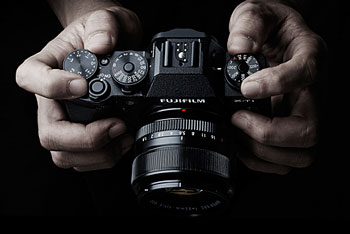It’s been quite a ride for the Fujifilm X series so far. Launched in March two years ago with the groundbreaking X-Pro1, the family of X cameras seems to grow faster than any of the competitors’ — despite sales being not that strong. The choice is yours, there’s the X-E2, X-A1, X-M1 and the series’ latest incarnation, the flagship X-T1, not to mention the XF1, XQ1, XS1, X100s, X20… That’s a great many cameras within a short time. I think you guess what I’m hinting at. Could less be more? I could easily go on and write that Fujifilm once again really really nails it with this weather-sealed X-T1 in a sturdy compact package, hoping that many of you will hit the order button and get great XF glass along with this promising little stunner. But there is more to a camera than just the specs and marketing behind it. Seems it just didn’t work out between the two of us.

BTW, as always all sample images are straight out of camera JPEGs to show the camera’s real and not post-processed performance.
This post sure doesn’t bring me any new friends. Common sense tells me to not even publish it. If you don’t have an open mind then please don’t bother and better hit an escape button. The following sounds heretic? But why just grin. It goes without saying that every camera maker has something to copy from these thoughtful Fujfilm X series cameras. For instance: choose on the lens between aperture A or M mode, and on the shutter speed and ISO dials whether auto or manual. Nifty, isn’t it.
And yes, an added A value on the prime lenses’ aperture ring sounds like a great idea. Requires some practice though. Why, Fujifilm, not a standard solution? Why do the zoom lenses have the A/M switch I’d prefer? Each lens requires a different shooting approach…
And who doesn’t like the sneaky view mode button on the right side of the X-T1’s EVF. Quickly select between EVF only (saves battery), EVF with eye sensor, eye sensor to switch between EVF and LCD, and finally LCD only. Neat!

Now that electronic viewfinder, praised as world’s closest to an old-school optical one, well, while the 2.36m dot EVF has an astonishing refresh rate of 54 fps in normal and low light conditions and it has a claimed response time of 0.005 seconds for a smoother view of moving subjects, it’s still not the real thing.
Especially in difficult light colors quickly turn overly saturated and plasticky, not to mention the glimmering shadows and blacks. Good old OVF vs. next-generation EVF is always a tradeoff. Either you want more superimposed information in the viewfinder. Or you want the closest possible rendition of what the human eye sees. EVFs are certainly the way to go, but let’s be honest, even the X-T1’s highly praised isn’t satisfying not only the discerning eye.

You may twist and turn this fact as long as you want. EVFs are still more gadget than accurate tool. I have not the slightest doubt in my mind that once mirrorless system cameras’ overall speed and performance match those of DSLRs we’ll also be able to enjoy the best of two viewfinder worlds: absolute clarity with overlaid shooting information. Each latest viewfinder comes a step closer to the real thing. Give it a year or two and we might be there.
A word on ergonomics: if system cameras get any smaller than the X-T1, then the miniaturization drive is killing its own children. Seriously. There has to be a balance between stable grip, portability and functionality. Ideally we could buy camera sizes according to the size of our hands. Or why doesn’t everyone wear the same size of socks?! That’s something not about to happen in the camera world — even though, at least, there could be a real market for left-handed cameras and no one does it.

I have small hands, smaller than my 15-year-old son’s, but the X-T1 is really at the breaking point of what I consider to be a size that’s a wise compromise between operation and functionality. For the sake of usefulness, small is already small enough! Also, as a case in point, the Fujinon pancakes have no aperture ring in order to make them compact and lightweight… Well it’s probably just a matter of getting used to, but for standard wide focal lengths I’d prefer a good old-fashioned aperture ring.
Now, even the X-T1’s Fujinon XF 18-55mm F2.8-4 R LM OIS kit lens has an aperture ring, albeit unmarked… The mighty XF 10-24mm F4 OIS with its exceptional build quality as well has no aperture ring. You’ll have to check the viewfinder or LCD each time if aperture value ever matters to your shooting… There is hope. The upcoming fast 16-55mm F2.8 and 50-140mm F2.8 zooms have an aperture ring. But again, why no standard approach, Fujifilm?

Talking body and ergonomics, the non-existant tactile feedback of the X-T1’s menu buttons as well needs some getting used to. There’s no click response. I like a “click confirmation,” but that’s probably an as unimportant critique as my overall hesitation to blindly praise the X-T1. Fujifilm provides so much good intention in a truly elaborate package that parts from the X series’ initial Leica-lookalike design.
With the X-T1, Fujifilm ventures into Olympus OM-D territory with that prominent “pentaprism” bulk. The Fujifilm looks like more camera and less computer than the OM-D E-M1 which rather reminds me of a joystick with its myriad of buttons and options.

But make no mistake. You can laugh off bigger cameras as things of the past, but to many photographers the serious mirrorless cameras don’t feel as solid and comfortable in the hand as “cumbersome” DSLRs — or my current favorite, the Nikon Df.
And one Fujifilm thing I don’t understand, something that made me sell the X100: be it manual focusing or enlarging images for reviewing, Fujifilm wants the user to overly work those dials and rings. To manually focus you have to turn and turn the lens ring, well the shot might already be lost. A bit more fine-tuned operation would certainly be appreciated.

But the X-T1’s real bummer — for my unimportant self at least: the exposure compensation dial cannot be locked — which isn’t necessarily a bad thing. But it happened again and again over the course of several days that the value was changed accidentally by simply carrying the camera with the neck strap.
Fujifilm told me the X-T1 has no exposure lock button because too many users complained about the compensation dial being locked. It would certainly help things if the dial would be a bit stiffer to operate to avoid accidental under- or overexposure. If you’re getting the X-T1, then repeat again and again your new mantra: CHECK THAT EXPOSURE COMPENSATION DIAL.

If other reviewers don’t stumble over this querulent dial I wonder did they really put the camera through its paces?!
Last but not least, another not really worthwhile nitpicking: once the camera goes into sleep mode and you want to switch it on quickly, you have to officially switch the camera off first and then on again. Guess a firmware update can fix that. For the moment it could mean precious instants lost.
Oh, and at standard setting in sunlight it was not possible to see the LCD screen.

Bottom line?
So no, I’m not really sold. And despite the promise of world’s fastest AF system I produced a considerable amount of, well, you get the drift. Roughly every two months Fujifilm’s releasing an X camera. I’m afraid they’re losing their focus and potential buyers are simply overwhelmed by the excess choice of X gear. But there is always hope, not least because of Fujifilm’s phenomenal X-Trans II sensor and the really exceptional build quality and fine finish of the camera bodies and especially the latest lenses. Even in dim light the sensor is perfectly capable to churn out clean, pleasant images with great detail and those unique Fujifilm colors. I guess for many this X-T1 really nails it. Add the simply amazing remote control from a smartphone or tablet. We two, I guess, were just not bonding because of mentioned quirks that might be a non-brainer to most of you.

+++ You can nevertheless order the Fujifilm X-T1 from Amazon (body / kit), B&H (body / kit) and Adorama (body / kit).


